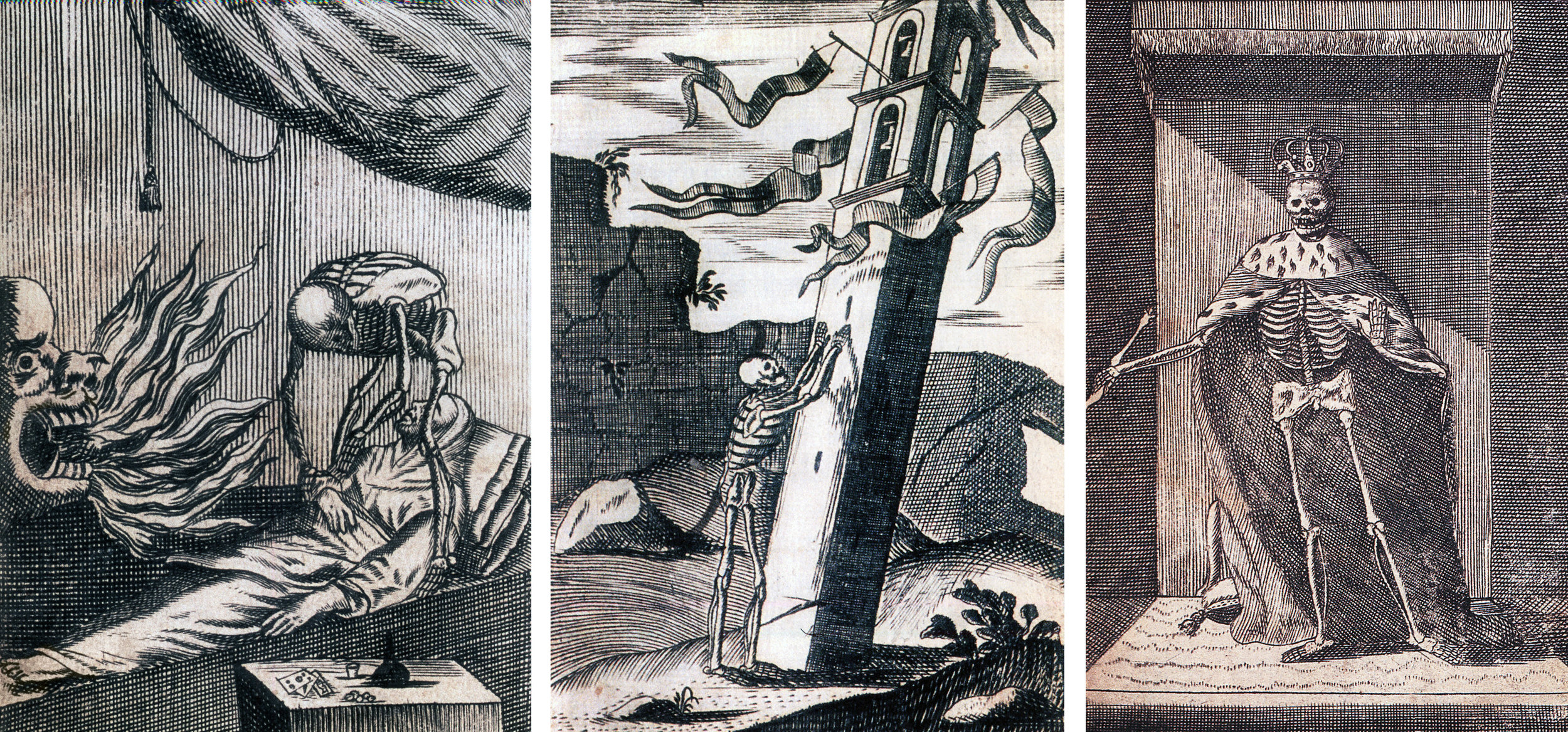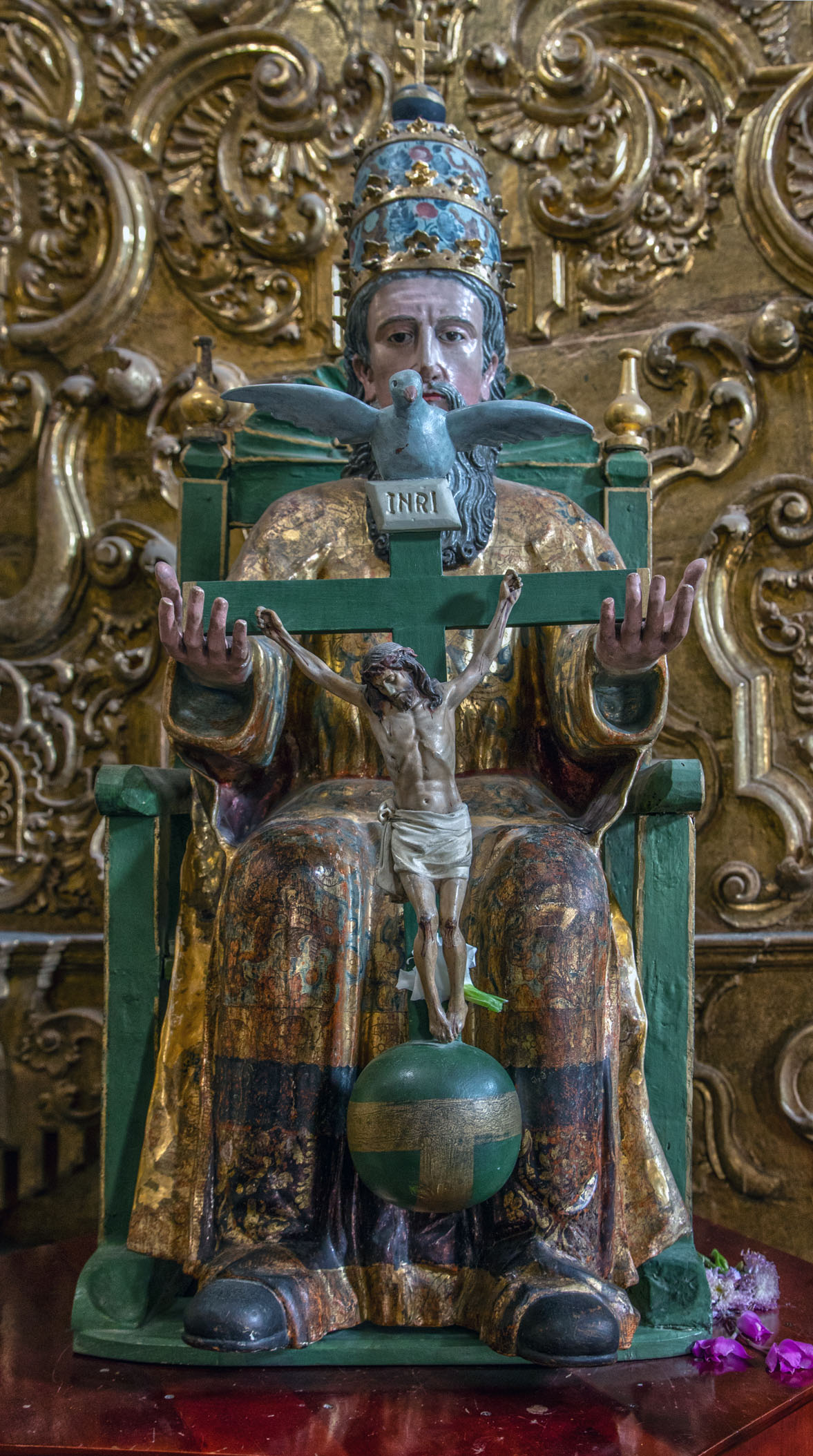The Portentous Life of Death
by Joaquin de Bolaños 1792
Death is unbridled, but in order to sweeten her memory, I present her gilded or disguised with a touch of jest, novelty, or grace…for I wish to amuse you with a little bit of mysticism, for I seek to undeceive you; separate the gold from the dross, profit from what is serious, laugh at what is ridiculous.
Written in Mexico at the end of the eighteenth century by Fr. Joaquín Bolaños, La portentosa vida de la muerte chronicles the exploits of Death as a female figure She frequently interacts with sinners, and even directly intercedes with God.*
In Spanish the word "muerte" (death in English) is a female noun, so it is common in Spanish-speaking countries for death to be personified as female figures.
* Constructing the Liminal: La Portentosa Vida de la Muerte by Katlyn Rochelle Smith, 2016
Illustrations by Francisco Agüera Bustamante
La alegoria de la muerte, 1856 by Tomas Mondragón
The imagery at the top of the painting gives the work a hierophantic meaning. It is a hand, "the hand of God", dimmed by a supernatural light that explodes from inside a cluster of clouds and packed with scissors, cut, according to the Christian tradition, the fine thread of life. This "divine" thread is what It divides the two sectors, that of life and that of death.*
*Allegory of death. Contents iconographic, symbolic and expressive pre-Columbian and Western matrix by Graciela Dragoski
José Guadalupe Posada
During the tumultuous years leading up to the Mexican Revolution of 1910, Posada relentlessly commented on the leading political and social issues of his day, satirizing everyone and anything. The most recurrent theme in his prints, the calavera (skull), was probably invented by his contemporary Manuel Manilla, but Posada popularized it as a national icon.*
Despite his current fame as a graphic artist, during his lifetime Posada’s artistic reputation was slight. Academic artists and art critics steeped in European traditions and techniques considered his prints—most produced for penny broadsides and popular newspapers—to be crude, ephemeral, and even scandalous.**
In 1920, Posada was rediscovered by a French artist, Jean Charlot, who brought his work to the attention of renowned muralists Diego Rivera and Jose Clemente Orozco.**
*Publication excerpt from an essay by Harper Montgomery, in Deborah Wye, Artists and Prints: Masterworks from The Museum of Modern Art, New York: The Museum of Modern Art, 2004, p. 124.
**Mexico: An Encyclopedia of Contemporary Culture and History
Posada Surrounded by His Admirers (Calaveras of Rivera, Orozco, Mendez, and Dr. Atl aka Gerardo Murillo) by Alfredo Zalce 1948, Linocut from the book Mexico and Modern Printmaking, The Revolution in the Graphic Arts, 1920 to 1950
Posada’s lithographs and wood-cuts… tap sources that are typically Mexican, for both the Indian heritage (skulls and death -goddesses are common in pre-Columbian art) and the Spanish heritage (the death-orientation of the monastic orders, and the dance-of-death and memento mori traditions) have blended in the average Mexican’s stoic, but far from humorless, view of death.*
Remembered almost exclusively for his Calavera Catrina, a skull wearing an ostentatious European hat, Posada produced hundreds of images on a broad range of daily news events and political satire with portrayals of not a few firing squads and lurid images of suicides. But Posada could charm and beguile as well, his artistic legacy extends to illustrations for children’s books as well.
If there are no small ironies in life and death, it is interesting to note that Posada benefited little in his lifetime from his Calaveras. The worldwide appreciation of the mute mocking laughter and biting satire of his images after his own death is a joke only a cynical Catrina would relish. Posada died penniless and was buried in a paupers grave.
*Posada’s Popular Mexican Prints, selected and edited by Roberto Berdecio and Stanley Applebaum
Image from Posada: A Century of Skeletons by Juan Villoro (Author), Mercurio López (Author), Montserrat Gali (Author), Helia Bonilla (Editor)
The broadside, the popular form in which Posada’s work is best documented and remembered, is a type of ephemeral street literature that first emerged in sixteenth-century Europe following the invention of the printing press in the previous century. The broadside, in a form similar to the commonly seen in Mexico, flourished in England and France from the 1820s, until the early twentieth century. Combining bold headlines, illustrations, and text, it featured scandals of all sorts, some entirely invented or recycled to boost sales.
Sheets like Grand Ball of Calaveras published to commemorate the Day of the Dead on November 2, were hawked at cemeteries.*
*Jose Guadalupe Posada and the Mexican Broadside by Diane Miliotes, Art Institute of Chicago
José Guadalupe Posada and Manuel Manilla
Manuel Manilla was the first illustrator to make engravings that humanized and caricatured death. In 1882 he started working at the printshop of Antonio Vanegas Arroyo, where he produced around 500 illustrations for broadsides, children books and other publications. He created the first "skulls" and became a major influence to Jose Guadalupe Posada, who became head engraver of the printshop after Manilla retired in 1892.
Arroyo sometimes combined the Calavera illustrations of Posada and Manilla on the same broadside, as can be seen in Esta Es De Don Quijote La Primavera.
This is About Don Quixote the First, the Matchless, the Giant Calavera (Esta es de Don Quijote la primera, la sin par la gigante calavera) after 1891
The Death of Don Quixote by Roberto Montenegro
SINCE NO things human are eternal, but rather decline from their beginnings to their ultimate end, especially the lives of men, and since don Quixote had no privilege from heaven to stay its course, his end came when least he expected…
Don Quixote de la Mancha is the classic tale in which Miguel de Cervantes Saavedra used satire and parody to ridicule the contemporary issues of his time and place. The artists of Posada’s time and after use irony and homage in equal portions; the symbolic literate use of Don Quixote combines with a kind of nod to Cervantes creation of epic satire, comedy and tragedy.
On using Don Quixote as a symbol in Latin America:
“Don Quixote” implicitly parodies the knight-conquerors of the New World, the conquistadors, whose flowery rhetoric and chivalrous posturing hardly masked their greed and brutality.
In the Latin American imagination , Don Quixote has functioned both as a symbol of the former colonies’ knotty old-world heritage and as a rebel figure whose absurd behavior pulls the rug out from under the Old World’s affectations and delusions of superiority.*
*The quixotic don by Reed Johnson, Los Angeles Times
Book Illustration 1921
Diego Rivera
Posada played a pivotal role in the development of Diego Rivera's work. Rivera was inspired by Posada's attention to working-class concerns as well as his expressive artistic technique. Years later, Rivera credited Posada as having been a great influence on his own artwork and direction.*
*http://www.mexonline.com/jose-guadalupe-posada.htm
The Day of the Dead, 1924. Fresco. Ministry of Education, Mexico City
In the years after the war, the movies had made murals irrelevant to most Mexicans.
In 1947 in Mexico City, Diego Rivera, after recovering from a struggle with bronchial pneumonia, roused himself one final time to paint a masterpiece. It was called Dream of Sunday Afternoon in Alameda Park. Rivera placed himself himself as a boy in the center of a vivid panorama of Mexican history and remembered pleasures. He is a pudgy boy with bulging eyes, holding an umbrella with a vulture’s head, wearing knickers and striped socks and the straw hat of the middle class.
Detail of Sueño de una tarde dominical en la Alameda Central (Dream of a Sunday Afternoon in the Alameda Central) - Diego Rivera Mural Museum - Mexico City - Mexico
A grown Frida is behind him, a protective hand on his shoulder. Beside the boy is la calavera Catrina as depicted by Jose Guadalupe Posada. Death gently holds the boy’s hand; her other hand is on the arm of a bowler-hatted Posada.
Also behind young Rivera is Jose Marti, a martyr to Cuban independence. To his right is Carmen Romero Rubio de Diaz, the second wife of the dictator. She is dressed in the high fashion of the 1890s, and is in the company of the dictator’s daughter from his first marriage.*
*Diego Rivera by Pete Hamill
Diego Rivera, Day of the Dead 1944
Calavera Against Imperialism by Alfredo Zalce
Cover of Calaveras vaciladoras de la guerra (Faltering Skulls of War)
Broadside published in 1939 using calaveras with likeness of Hitler and Franco.
In the interwar era, cities across the Americas became hubs in transnational networks that linked radicals and revolutionaries of all kinds: anarchists, Wobblies, Socialists, Communists, Garveyites, political exiles and vanguard intellectuals. While there were a number of these urban hubs — New York, Tampa, New Orleans and Havana all played a role — the largest by far was Mexico City.*
*Radicals, Revolutionaries and Exiles: Mexico City in the 1920s by Barry Carr
Contemporary mural of a half-face Catrina in the Mercado de Tlacolula, Oaxaca.
Dia de Muertos celebrates death as a part of the human experience: Every living thing will eventually die. Every human being, no matter how beautiful or well-dressed, will eventually be exposed as nothing more than a skeleton and skull. The half-decorated calacas and calaveras recognize this duality.*
*https://www.nationalgeographic.org/media/dia-de-los-muertos/
Ester Hernández, One of the Bay Area’s Las Mujeres Muralistas uses a catrina to mock agribusiness. Hernández is a Chicana of Yaqui and Mexican heritage. She was born and raised by farm worker parents in Dinuba, a small town in the central San Joaquin Valley of California. She was influenced by her family's involvement in the Farm Workers Movement and the politically charged atmosphere at the University of California, Berkeley.
One of her most renowned works of art is Sun Mad, a screen print that "speaks of the impact of the overuse of pesticides and the effect they have on the farmworkers, consumers and the environment.*
*Wikipedia
Posada’s fun loving calavera is alive and well in America in annual city festivals and art walks.























































































